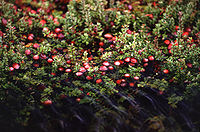
Photo from wikipedia
‘Draper’ northern highbush blueberry (Vaccinium corymbosum L.) is a widely-planted mid-season cultivar with excellent fruit quality. Under the climatic conditions of Southwestern British Columbia, Canada, and Northwestern Washington, USA, it… Click to show full abstract
‘Draper’ northern highbush blueberry (Vaccinium corymbosum L.) is a widely-planted mid-season cultivar with excellent fruit quality. Under the climatic conditions of Southwestern British Columbia, Canada, and Northwestern Washington, USA, it expresses a physiological disorder causing spontaneous green fruit drop (GFD) of up to half of the developing crop just prior to onset of the fruit coloring phenophase. Reduction of economic losses due to GFD required identification of the cause of this disorder and development of an agronomic solution that would reduce fruit drop. In 2014, two initial experiments were conducted to compare three foliar Ca products under a range of N fertilization rates. In 2015 and 2016, three locations were used in a first step to optimizing rates and timings of foliar Ca application. Initial experiments determined that higher N fertilization rates exacerbate GFD but that foliar Ca corrects the condition. Multi-site, multi-year trials identified key rates and timings for foliar Ca application to provide an agronomic solution for commercial growers. These trials identified an acute fruit Ca deficiency as the cause of GFD, and that foliar calcium applied frequently at high concentration from mid-bloom onward can be effective in reducing GFD, often to negligible levels. This condition has now been reported in several production regions around the world.
Journal Title: Agriculture
Year Published: 2019
Link to full text (if available)
Share on Social Media: Sign Up to like & get
recommendations!